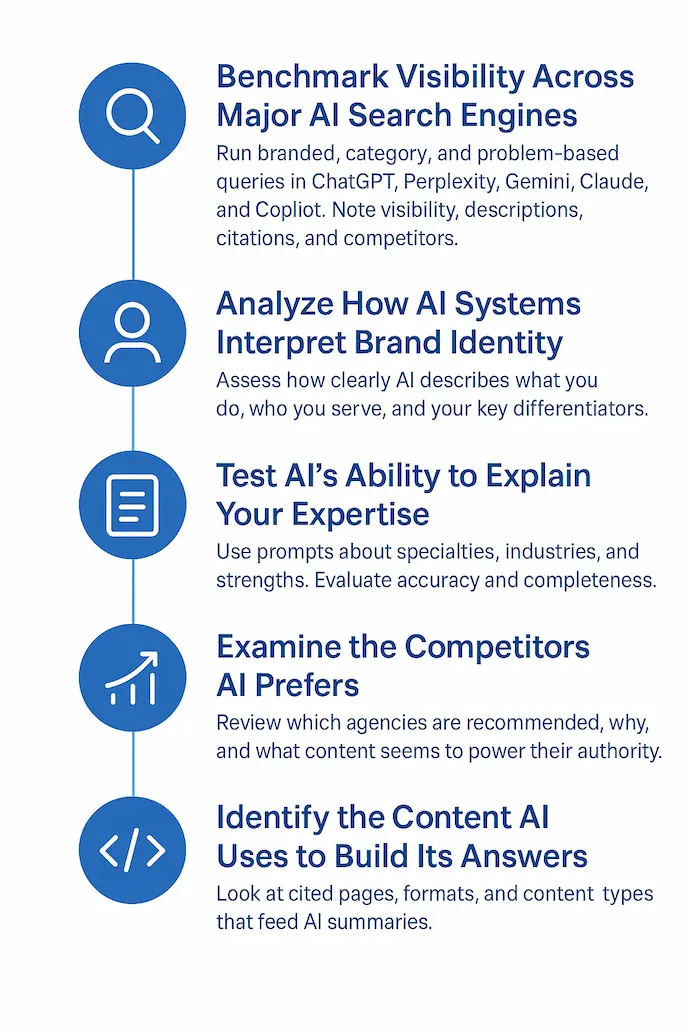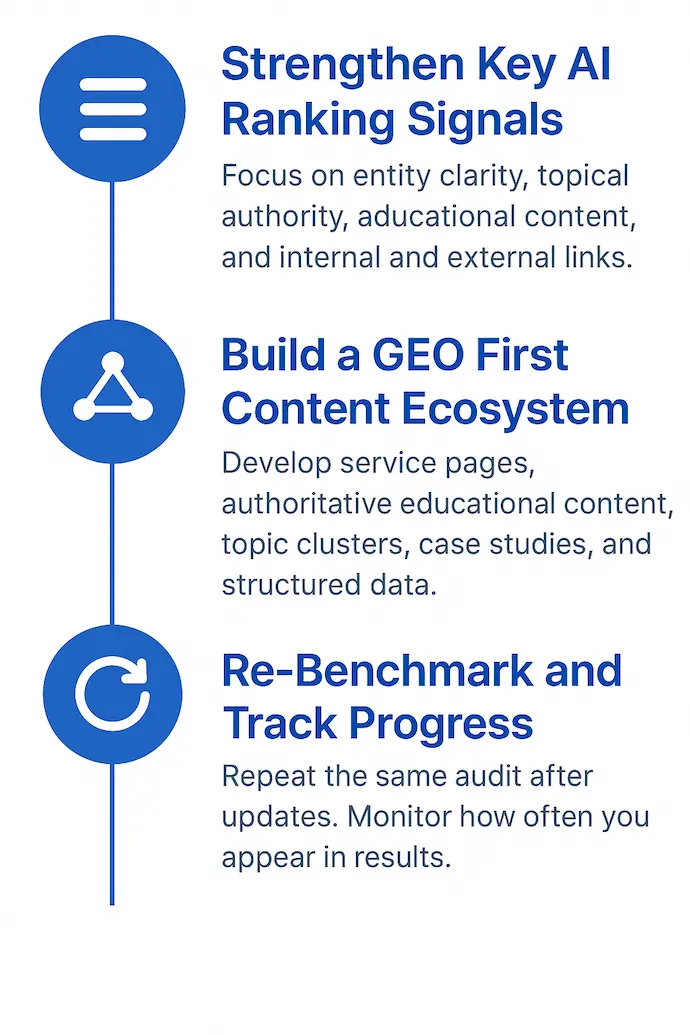November 24, 2025
Artificial intelligence is reshaping how people discover information and make decisions. Search is shifting from long lists of links to synthesized answers generated directly inside platforms like ChatGPT, Gemini, Perplexity, Claude, and Microsoft Copilot. These systems do not simply retrieve information. They analyze, interpret, summarize, and recommend.
In this new landscape, brand visibility is measured by presence inside AI responses. If a brand is not mentioned, cited, or understood within these environments, it risks being invisible to users who allow AI systems to guide their choices. This is the beginning of what many organizations refer to as Generative Engine Optimization, a practice focused on helping brands appear accurately and consistently inside AI-generated search experiences.
This guide provides a complete framework for auditing a brand’s visibility in AI search results. It is designed for organizations that want to understand how AI systems interpret their brand and what steps they can take to strengthen their presence.
Why AI Visibility Audits Are Now Essential
AI systems influence early research, evaluation, comparisons, and decision-making. Users no longer rely solely on traditional search results. Instead, they ask AI questions such as:
-
Who are the top marketing agencies in my area
-
How can I improve the performance of my PPC campaigns
-
What is the best way to drive more qualified leads
The AI system produces an answer that blends information from multiple sources. It may cite references, list recommendations, or generate guidance based on what it considers authoritative.
If a brand is absent from these synthesized answers, it is removed from the consideration stage before the customer ever sees a list of websites.
Auditing AI visibility helps identify:
-
whether the brand appears in relevant AI-generated answers
-
how accurately AI systems describe the brand
-
which competitors are favored
-
whether citations reference the brand’s content
-
which topics and services are associated with the brand
-
where gaps exist in digital authority and topical coverage
This new form of visibility is not a future concept. It is already shaping purchasing behavior today.
Step 1: Benchmark Visibility Across Major AI Search Engines

The first step is to test how major AI platforms respond to key queries. Each platform operates differently, so a complete audit includes all significant engines.
ChatGPT
Optimized for conversational answers. Often summarizes without citations. Focuses on entity understanding and general authority.
Perplexity
Combines conversational responses with transparent citations. This makes it one of the most important platforms for understanding how AI interprets web content. More guidance on this can be found in the article about AI search engines.
Google Gemini and AI Overviews
Directly influenced by organic SEO signals. Relies on structured data, content depth, and clear topical authority.
Claude
Popular for its accuracy and preference for high-quality educational content.
Microsoft Copilot
Influenced by Bing’s index and OpenAI models. Often blends traditional search with AI recommendations.
What to Ask During This Benchmark
Gather responses to three categories of prompts.
Branded Queries
These reveal how well AI systems understand the brand’s identity.
Examples:
-
What is [Brand Name]
-
What services does [Brand Name] provide
-
Is [Brand Name] considered a reputable company
Category Queries
These determine whether the brand appears when users search for providers.
Examples:
-
Best SEO agencies in Denver
-
Leading PPC agencies for service-based businesses
-
Top digital marketing firms for e-commerce
Problem Based Queries
These reveal whether AI associates the brand with key solutions.
Examples:
-
How can a business improve its SEO performance
-
How can companies generate more qualified leads
-
How do organizations choose a trustworthy marketing agency
Record:
-
whether the brand appears
-
how it is described
-
whether the description is accurate
-
whether the brand is recommended
-
which competitors are mentioned
-
what sources are cited
This baseline highlights immediate opportunities.
Step 2: Analyze How AI Systems Interpret Brand Identity
AI search engines rely heavily on entity understanding. An entity is a concept or object that AI can recognize, categorize, and describe. For a brand to appear in AI generated results, the system must clearly understand:
-
what the organization does
-
who it serves
-
what expertise it provides
-
what differentiates it from alternatives
-
which topics it is authoritative on
-
whether it is trusted across the web
This information is built from a variety of signals, including:
-
structured service pages
-
educational content
-
third party mentions
-
case studies
-
consistent information across platforms
-
topical depth
-
links between related topics
Strong foundational SEO supports this process. Clear service pages, like those seen in Search Engine Optimization services, help AI understand the core expertise of a brand. Clean topic segmentation helps AI connect services to related knowledge areas. Educational assets help AI recognize credibility.
If AI struggles to describe a brand accurately, entity clarity is weak. This is one of the most important findings a visibility audit can reveal.
Step 3: Test AI’s Ability to Explain Your Expertise
Next, prompt AI platforms with questions that should lead to clear descriptions of the brand’s capabilities:
-
What does this organization specialize in
-
What industries does it support
-
What makes this company a strong choice for digital marketing
-
What services are this company best known for
Evaluate:
-
accuracy
-
completeness
-
clarity
-
alignment with brand positioning
-
missing strengths
-
incorrect assumptions
If the response is vague or incomplete, the organization’s digital footprint is not providing a strong enough set of signals.
Service pages that clearly define offerings, like the page for Generative Engine Optimization, and supporting resources such as the section on optimizing for the next era of search, help reinforce how AI systems categorize a brand.
Step 4: Examine the Competitors AI Prefers
AI generated recommendations often include a mix of well known firms, niche specialists, and unexpected competitors. The list is rarely random. Recommendations are influenced by:
-
topical authority
-
clarity of positioning
-
depth of educational content
-
how well the brand is represented across the web
-
citation frequency
-
expert level guides
-
overall credibility
Studying the competitors AI recommends provides insights into:
-
content types that resonate with the AI model
-
topic clusters that AI treats as authoritative
-
gaps in coverage within your own content ecosystem
-
areas where competitors are outperforming the brand
This stage of the audit reveals where adjustments can help improve visibility.
Step 5: Identify the Content AI Uses to Build Its Answers
AI generated responses are created by synthesizing content from thousands of sources. Some platforms, like Perplexity and Bing, show clear citations. Others, like ChatGPT, may not display them but still rely on underlying patterns from the web.
Look for whether the AI platform cites:
-
the brand’s educational content
-
competitor guides
-
industry publications
-
aggregator content
-
outdated information
-
content lacking depth
-
resources that contradict the brand’s messaging
If AI does not reference the brand’s content, it often means:
-
the brand has not produced strong educational material
-
the content is not structured in a way AI can interpret effectively
-
the content lacks depth compared to competitors
-
the brand has not built sufficient topical authority
This is where strategic educational content becomes crucial. Pieces like Maximizing Agility With AI SEO Tools act as authority builders that AI can confidently reference.
Step 6: Strengthen Key AI Ranking Signals

An audit highlights the signals that need reinforcement. The following elements have the greatest impact on AI visibility:
Entity clarity
AI must be able to clearly define the brand and its core services.
Topical authority
Depth across core topics increases the likelihood of being included in AI generated answers.
Educational content
Tutorials, guides, frameworks, and research driven content are favored.
Structured service pages
Clear definitions and supporting subpages help AI interpret expertise.
External credibility
Mentions, citations, partnerships, and case studies strengthen trust.
Clean internal linking
Internal connections help AI understand topic relationships and expertise.
Relevance driven internal linking, supported by resources such as the SEO fundamentals article SEO 101, reinforces importance of foundational clarity.
Consistent digital signals
Brand descriptions, location details, service lists, and identifiers should match across all platforms.
Step 7: Build a GEO First Content Ecosystem
Once the audit reveals how AI systems interpret the brand, the next step is to build a content ecosystem designed for the generative search era.
A GEO forward content strategy includes:
Deep, structured service pages
Pages must provide clarity, scope, value, and detailed explanations of how services work. Strong examples include clearly organized service pages such as those in the Search Engine Optimization services section.
Authority centered educational content
Guides, thought leadership pieces, industry breakdowns, and insightful comparisons help AI trust the brand’s voice.
Topic clusters
AI needs clear content pathways that demonstrate expertise across related subjects. Clusters can include:
-
AI search
-
technical SEO
-
reporting and analytics
-
PPC strategy
-
conversion optimization
-
content frameworks
Case studies
High quality case studies provide real world evidence of success and help AI understand which problems the brand solves.
Structured data
Schema markup reinforces meaning and helps AI interpret content correctly.
Step 8: Re Benchmark and Track Progress
After adjustments are made, repeat the initial audit:
-
use the same prompts
-
use the same AI platforms
-
look for changes in brand inclusion
-
assess improvements in accuracy
-
measure shifts in competitor presence
-
monitor citation updates
-
evaluate clarity of generated answers
AI visibility becomes a measurable performance indicator. Improvements here often predict future gains in traditional organic rankings, since both systems rely on similar forms of topical clarity and expertise signals.
Final Thought: AI Visibility Is Now a Key Competitive Advantage
AI generated answers are becoming the primary layer of discovery in digital search. Brands that actively audit and improve their visibility within AI systems will have a significant advantage over those relying solely on traditional SEO practices. The shift to generative search is not temporary. It represents the long term direction of information retrieval.
Organizations that implement frameworks rooted in Generative Engine Optimization will position themselves to be recommended, referenced, and trusted within the tools that shape the future of how users search and decide.
Get your rankings back today.
Ready to make your reports actually matter? Let’s turn your data into stories that sell results.